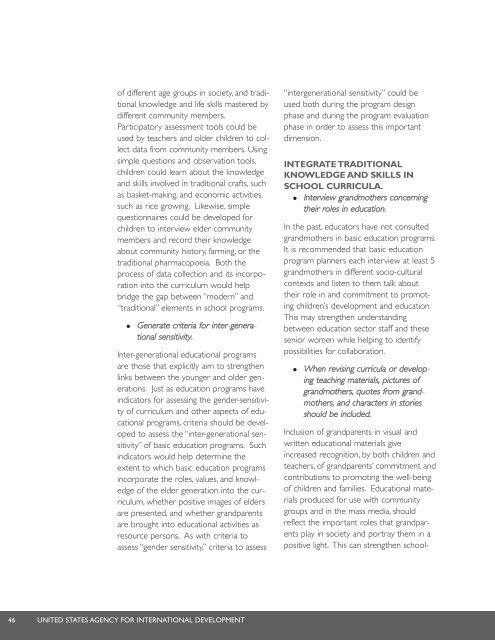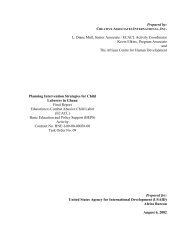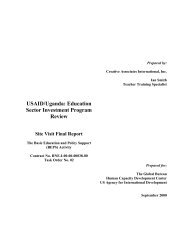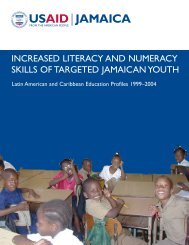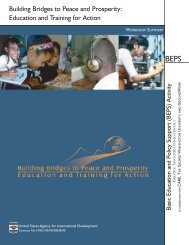of different age groups in society, <strong>and</strong> traditionalknowledge <strong>and</strong> life skills mastered bydifferent community members.Participatory assessment tools could beused by teachers <strong>and</strong> older children to collectdata from community members. Usingsimple questions <strong>and</strong> observation tools,children could learn about the knowledge<strong>and</strong> skills involved in traditional crafts, suchas basket-making, <strong>and</strong> economic activities,such as rice growing. Likewise, simplequestionnaires could be developed forchildren to interview elder communitymembers <strong>and</strong> record their knowledgeabout community history, farming, or thetraditional pharmacopoeia. Both theprocess of data collection <strong>and</strong> its incorporationinto the curriculum would helpbridge the gap between “modern” <strong>and</strong>“traditional” elements in school programs.• Generate criteria for inter-generationalsensitivity.Inter-generational educational programsare those that explicitly aim to strengthenlinks between the younger <strong>and</strong> older generations.Just as education programs haveindicators for assessing the gender-sensitivityof curriculum <strong>and</strong> other aspects of educationalprograms, criteria should be developedto assess the “inter-generational sensitivity”of basic education programs. Suchindicators would help determine theextent to which basic education programsincorporate the roles, values, <strong>and</strong> knowledgeof the elder generation into the curriculum,whether positive images of eldersare presented, <strong>and</strong> whether gr<strong>and</strong>parentsare brought into educational activities asresource persons. As with criteria toassess “gender sensitivity,” criteria to assess“intergenerational sensitivity” could beused both during the program designphase <strong>and</strong> during the program evaluationphase in order to assess this importantdimension.INTEGRATE TRADITIONALKNOWLEDGE AND SKILLS INSCHOOL CURRICULA.• Interview gr<strong>and</strong>mothers concerningtheir roles in education.In the past, educators have not consultedgr<strong>and</strong>mothers in basic education programs.It is recommended that basic educationprogram planners each interview at least 5gr<strong>and</strong>mothers in different socio-culturalcontexts <strong>and</strong> listen to them talk abouttheir role in <strong>and</strong> commitment to promotingchildren’s development <strong>and</strong> education.This may strengthen underst<strong>and</strong>ingbetween education sector staff <strong>and</strong> thesesenior women while helping to identifypossibilities for collaboration.• When revising curricula or developingteaching materials, pictures ofgr<strong>and</strong>mothers, quotes from gr<strong>and</strong>mothers,<strong>and</strong> characters in storiesshould be included.Inclusion of gr<strong>and</strong>parents in visual <strong>and</strong>written educational materials giveincreased recognition, by both children <strong>and</strong>teachers, of gr<strong>and</strong>parents’ commitment <strong>and</strong>contributions to promoting the well-beingof children <strong>and</strong> families. <strong>Education</strong>al materialsproduced for use with communitygroups <strong>and</strong> in the mass media, shouldreflect the important roles that gr<strong>and</strong>parentsplay in society <strong>and</strong> portray them in apositive light. This can strengthen school46 UNITED STATES AGENCY FOR INTERNATIONAL DEVELOPMENT
community ties by increasing teachers’ <strong>and</strong>children’s appreciation of the knowledge<strong>and</strong> experience of the gr<strong>and</strong>parents <strong>and</strong> byincreasing gr<strong>and</strong>parents’ support forschools.• Use components of “Service-<strong>Learning</strong>” <strong>and</strong> constructivistapproaches to collect data fromgr<strong>and</strong>mothers <strong>and</strong> incorporate theminto the curriculum. 8The Service-<strong>Learning</strong> concept, taken in itsbroadest sense, provides many opportunitiesto use traditional knowledge stored inthe memories of village elders as a basisfor children to develop strong identities.Children can reach out to gr<strong>and</strong>mothers<strong>and</strong> community members through variousteacher-led activities. Children then areguided to construct a history or incorporateinto the curriculum the various ideasthey have processed or learned. Service-<strong>Learning</strong> has been adopted in many internationaleducation projects <strong>and</strong> can helpchildren to grow up to be citizens who areengaged in their society, <strong>and</strong> who are moretolerant, compassionate, <strong>and</strong> underst<strong>and</strong>ingof others.The following are recommendationsfor using Service-<strong>Learning</strong> ideas toobtain <strong>and</strong> develop information from<strong>Gr<strong>and</strong>mothers</strong>:– Who am I? Assign children to askfamily members, including gr<strong>and</strong>mothers,to answer the child’s question:“Who am I?”This is an activity to help childrendefine their own identity, in the family,<strong>and</strong> in the community. A preliminarystep would be to have classroomteachers <strong>and</strong> students construct a setof questions related to the family, theethnic group, the neighborhood, theoccupations of the parents <strong>and</strong>gr<strong>and</strong>parents, <strong>and</strong> the primary productsof the village. Classroom activitiesbased on this information canhelp reinforce the children’s identity<strong>and</strong> give them more positive feelingsabout their community.– Living History.Assign children to interview elders intheir family or neighborhood, includinggr<strong>and</strong>mothers, on a topic relatedto the history of the neighborhoodor village.Teachers can make this apart of the history curriculum.Theteacher might change the topic slightlyeach year <strong>and</strong>, for example, includeexperiences of men <strong>and</strong> women duringa war, during a famine, beforeindependence, or when learning tookplace before there were schools. Thechildren could then come back tothe classroom, share their findings,write them up, <strong>and</strong> organize theminto a small booklet that could beshared in the community.The childrencould also develop skits toshow what they have learned abouttheir village history.– Making curriculum relevant.Research on education programs indeveloping countries has suggestedthat when curriculum is not relevantto children’s lives, it becomes a factorin children’s decreased attendance<strong>and</strong> increased drop-out rates.Curriculum that engages childrenshould include elements of the locallanguage, history, cultural values <strong>and</strong>8 The National Service-<strong>Learning</strong> Clearinghouse defines service-learning as a “teaching <strong>and</strong> learning strategy that integratesmeaningful community service with instruction <strong>and</strong> reflection to enrich the learning experience, teach civic responsibility,<strong>and</strong> strengthen communities.”The core concept of service-learning is that it “combines service objectives with learningobjectives with the intent that the activity change both the recipient <strong>and</strong> the provider.This is accomplished by combiningservice tasks with structured opportunities that link the task to self-reflection, self-discovery, <strong>and</strong> the acquisition <strong>and</strong> comprehensionof values, skills, <strong>and</strong> knowledge content.”GRANDMOTHERS:THE LEARNING INSTITUTION47
- Page 1 and 2:
GRANDMOTHERS:A LEARNING INSTITUTION
- Page 3:
GRANDMOTHERS:A LEARNING INSTITUTION
- Page 11 and 12:
EXECUTIVE SUMMARYSociety itself fai
- Page 13 and 14: Education, the Bernard Van LeerFoun
- Page 15 and 16: SEVERAL FACTORS CONTRIBUTE TO THELI
- Page 17: - Who am I? Assign children to askf
- Page 20 and 21: in educational activities on home t
- Page 22 and 23: “A grandmother’s understandingo
- Page 24 and 25: “Culture tells peoplehow to view
- Page 26 and 27: attention given to grandmothers’
- Page 28 and 29: social work, including family syste
- Page 30 and 31: mation from Azerbaijan (McNulty 200
- Page 32 and 33: “The status of eldersin tradition
- Page 34 and 35: “As women, thegrandmothers haveli
- Page 36 and 37: members often consult the moreexper
- Page 38 and 39: “Social capital is a community’
- Page 40 and 41: In a collaborative effort between
- Page 42 and 43: in-laws and the additional free tim
- Page 44 and 45: "Involving grandmothersin community
- Page 50 and 51: CULTURALLY-ADAPTED EDUCATIONMATERIA
- Page 52 and 53: strated the power of participatory
- Page 54 and 55: effects of the new ideas, their con
- Page 57 and 58: V. GRANDMOTHERS: A LEARNING INSTITU
- Page 59 and 60: Many health and development workers
- Page 61 and 62: VI. RECOMMENDATIONS FORBASIC EDUCAT
- Page 63: parents themselves did not go to sc
- Page 67 and 68: of millions. On the other hand, som
- Page 69: teachers, teacher abuse of children
- Page 73 and 74: APPENDIX B:ANNOTATEDREFERENCES ON T
- Page 75 and 76: acceptable for younger women to mak
- Page 77 and 78: showed that men are not directly in
- Page 79 and 80: ecause they had more time to devote
- Page 81 and 82: matrilineal or patrilineal areas
- Page 83 and 84: diet, work, fetal development, sexu
- Page 85 and 86: in the family and social networks.
- Page 87 and 88: elated, for example, to early child
- Page 89 and 90: REFERENCESAdams, A. M., S. Madhavan
- Page 91 and 92: BASICS and LINKAGES. 1998. Influenc
- Page 93 and 94: Childhood Education and Development
- Page 95 and 96: Krishna, A. and N. Uphoff. June 199
- Page 97 and 98: Sear, R., R. Mace, and I. A. McGreg
- Page 99 and 100: ABOUT THE AUTHORThis review was pre


